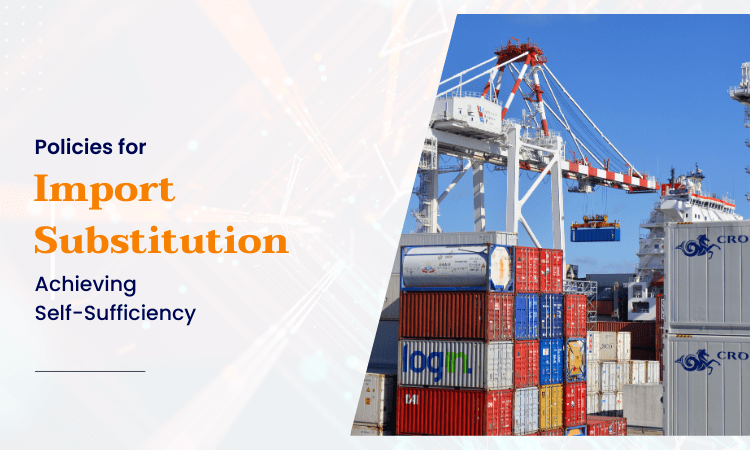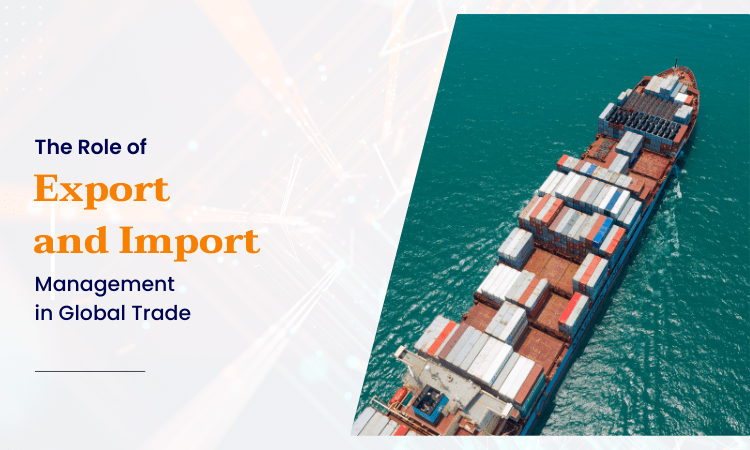Introduction:
Welcome to our comprehensive guide on the role of export and import management in international business. In this blog post, we will delve into the significance of effective export promotion and import substitution strategies, along with exploring the advantages they bring to businesses. Whether you are new to this field or looking to enhance your knowledge, this professional guide is your one-stop resource. Stay tuned to learn more!
Import Substitution vs. Export Promotion: Understanding the Differences and Benefits:
In the realm of international business, fostering economic growth often hinges on a crucial choice: import substitution or export promotion. While both strategies aim to boost a nation’s economy, they operate on fundamentally different principles, offering distinct advantages and drawbacks.
Import Substitution:
This inward-focused approach seeks to reduce reliance on foreign imports by encouraging domestic production of goods and services. This often involves government intervention through tariffs, quotas, and subsidies to shield domestic industries from international competition.
Advantages:
- Promotes industrial development: Can nurture nascent industries, fostering self-sufficiency and diversification.
- Job creation: Stimulates domestic production, potentially leading to increased employment opportunities.
- National security: Enhances control over critical goods and reduces dependence on potentially unreliable foreign suppliers.
Disadvantages:
- Higher consumer prices: Protected domestic industries may operate less efficiently, leading to higher costs for consumers.
- Reduced competition: Sheltered from competition, domestic firms may have less incentive to innovate and improve.
- Limited market access: Focus on domestic market can hinder access to larger export markets and potential economies of scale.
Export Promotion:
This outward-oriented strategy prioritizes selling goods and services to the international market. Governments typically employ measures like tax breaks, export subsidies, and trade agreements to facilitate exports.
Advantages:
- Economic growth: Access to larger markets fosters increased production, leading to economic expansion and job creation.
- Improved competitiveness: Exposure to international competition drives innovation and efficiency, benefiting both producers and consumers.
- Foreign exchange earnings: Increased exports generate valuable foreign currency, which can be used for imports and infrastructure development.
Disadvantages:
- Reliance on external markets: Vulnerability to fluctuations in global demand and trade policies.
- Focus on specific industries: May neglect development of other sectors crucial for long-term growth.
- Potential resource exploitation: May lead to unsustainable practices to remain competitive in the global market.

The Crucial Role of Export and Import Management in International Business:
In today’s interconnected world, businesses are increasingly looking beyond their borders for growth opportunities. This expansion into international markets opens a door to new customers, resources, and revenue streams, but it also introduces a layer of complexity. This is where export and import management comes in, playing a crucial role in ensuring the smooth flow of goods and services across borders.
Beyond borders, beyond challenges:
Export and import management encompasses a diverse set of tasks, from navigating foreign trade regulations and logistics to managing financial risks and cultural nuances. Whether a company chooses an export promotion strategy, focusing on selling abroad, or an import substitution approach, prioritizing domestic production, effective management is vital for success.
For export-oriented businesses:
- Market research and selection: Identifying viable markets, understanding cultural preferences, and complying with regulations are crucial.
- Logistics and shipping: Efficient transportation, warehousing, and documentation ensure timely deliveries and minimize costs.
- Payment methods and risk management: Securing reliable payment methods and mitigating risks associated with currency fluctuations and international transactions are essential.
- Marketing and communication: Tailoring marketing strategies to foreign audiences and fostering effective communication are key to building relationships and brand awareness.
For import-reliant businesses:
- Supplier sourcing and selection: Identifying reliable suppliers, negotiating fair prices, and ensuring quality control are critical.
- Customs clearance and compliance: Understanding and adhering to import regulations and duties is essential.
- Inventory management and logistics: Optimizing inventory levels and managing transportation costs are crucial for efficiency.
- Currency exchange and risk management: Strategies to manage currency fluctuations and mitigate financial risks are necessary.
Beyond just processes:
Effective export and import management goes beyond simply ticking boxes. It requires a deep understanding of international trade practices, cultural sensitivities, and the ever-evolving global landscape. Businesses that invest in skilled professionals and robust management systems are better equipped to navigate the complexities of international trade, capitalize on opportunities, and achieve sustainable growth.

How Export Promotion Can Drive Economic Growth and Development:
For many nations, fostering economic prosperity hinges on a powerful tool: export promotion. This outward-oriented strategy prioritizes selling goods and services to the international market, unlocking diverse benefits that can propel a nation towards sustainable growth and development.
Fueling the engine of growth:
Export promotion works its magic by:
- Expanding markets: Exposing domestic businesses to larger international markets allows them to scale up production, leading to increased job creation and economic activity.
- Boosting competitiveness: Facing global competition drives innovation and efficiency within domestic industries, ultimately benefiting both producers and consumers.
- Generating foreign exchange: Increased exports bring in valuable foreign currency, which can be used for essential imports, infrastructure development, and investment.
- Diversifying the economy: Reliance on a wider range of export products lessens vulnerability to fluctuations in specific sectors, promoting economic stability.
Beyond just numbers:
The impact of export promotion goes beyond mere economic indicators. It can:
- Attract foreign investment: Increased export performance can attract foreign investors, bringing in additional capital and expertise.
- Enhance technological advancement: Exposure to global trends and competition encourages the adoption of new technologies and production methods.
- Improve living standards: Increased economic activity and foreign exchange earnings can lead to higher wages, improved infrastructure, and better living standards for citizens.
Making it work:
Successful export promotion requires a multifaceted approach, including:
- Government support: Governments can provide tax breaks, export subsidies, and trade agreements to facilitate exports.
- Trade infrastructure: Investment in efficient transportation, logistics, and communication networks is crucial.
- Skilled workforce: Developing a workforce proficient in international trade practices and foreign languages is vital.
- Quality and competitiveness: Domestic industries must focus on producing high-quality goods and services at competitive prices.
Not a one-size-fits-all solution:
While export promotion offers significant benefits, it’s crucial to consider its potential drawbacks, such as dependence on external markets and potential resource exploitation. Ultimately, the success of this strategy depends on a nation’s specific economic context, resource endowment, and development goals.
Import Substitution Strategies: Strengthening Domestic Industries:
In the development journey of many nations, fostering self-reliance and industrial growth often takes center stage. Import substitution, a strategy aiming to reduce reliance on foreign imports by encouraging domestic production of goods and services, emerges as a potential answer. While not without its drawbacks, when implemented strategically, it can hold the key to strengthening domestic industries and boosting economies.
Building from within:
Import substitution works by:
- Protecting nascent industries: Tariffs, quotas, and subsidies shield domestic producers from established international competition, allowing them to gain a foothold and grow.
- Diversifying the economy: Encouraging production of a wider range of goods reduces dependence on specific imported products, fostering resilience.
- Promoting technological advancement: Investment in domestic production drives innovation and technological development, potentially leading to future export capabilities.
- Job creation: Increased domestic production translates to job opportunities within the newly established industries.
Beyond just production:
The impact of import substitution extends beyond manufacturing:
- National security: Reducing reliance on foreign suppliers for critical goods can enhance national security and self-sufficiency.
- Infrastructure development: Investment in domestic production often necessitates infrastructure improvements, benefiting the wider economy.
- Social development: Job creation and industrial growth can lead to improved living standards and social development.
A nuanced approach:
However, import substitution also comes with potential drawbacks:
- Higher consumer prices: Protected domestic industries may operate less efficiently, leading to higher costs for consumers.
- Reduced competition: Sheltered from competition, domestic firms may lack incentive to innovate and improve, hindering long-term competitiveness.
- Limited market access: Focusing solely on the domestic market can hinder access to larger export markets and potential economies of scale.
Exploring the Advantages of Import Substitution and Export Promotion:
In the realm of international trade, two distinct strategies vie for attention: import substitution and export promotion. Each approach boasts unique advantages, catering to different economic contexts and development goals. Let’s delve into their strengths and understand which path might be better suited for your nation’s journey.
Import Substitution: Building Foundations at Home:
This inward-focused strategy prioritizes reducing reliance on foreign imports by nurturing domestic production. Here’s where it shines:
- Nurturing nascent industries: Tariffs and subsidies shield young industries from global competition, allowing them to gain a foothold and develop local expertise.
- Diversifying the economy: Reducing dependence on specific imports fosters resilience, mitigates external shocks, and promotes a broader industrial base.
- Job creation: Increased domestic production translates to employment opportunities within newly established industries, boosting local economies.
- National security: Secure access to critical goods, independent of foreign suppliers, enhances self-sufficiency and preparedness.
Export Promotion: Stepping onto the Global Stage:
This outward-oriented approach focuses on selling goods and services to the international market. Its advantages shine bright:
- Economic growth: Access to larger markets fuels production, job creation, and overall economic expansion.
- Enhanced competitiveness: Exposure to global competition drives innovation, efficiency, and continuous improvement in quality and cost.
- Foreign exchange earnings: Increased exports bring in valuable foreign currency, which can be reinvested in infrastructure, technology, and further development.
- Diversification of export markets: Spreading exports across multiple markets reduces vulnerability to fluctuations in any single region.
Finding the Right Balance: A Nuanced Approach:
It’s important to remember that both strategies come with drawbacks. Import substitution can lead to higher consumer prices and reduced competition, while export promotion can create dependence on external markets and neglect crucial domestic sectors.
Therefore, the optimal approach often lies in a balanced mix. Tailoring the strategy to a nation’s specific resource endowment, development goals, and global trade partnerships is crucial. Hybrid models that combine elements of both approaches can ensure self-sufficiency while fostering international competitiveness.
The Implications of Import Substitution and Export Promotion for Developing Nations:
For developing nations seeking economic prosperity, choosing between import substitution (IS) and export promotion (EP) strategies can be a pivotal decision. Each approach boasts advantages and drawbacks, leaving policymakers with a complex landscape to navigate. Let’s explore the implications of each path.
Import Substitution: Building Homegrown Industries:
This inward-focused strategy aims to reduce dependence on imports by nurturing domestic production. While offering potential benefits like:
- Industrial development: Fostering new industries through protectionist measures creates employment and diversifies the economy.
- Technological advancement: Investment in domestic production spurs innovation and technological adoption.
- National security: Self-sufficiency in critical goods reduces reliance on potentially unreliable foreign suppliers.
IS also carries risks:
- Higher consumer prices: Protected domestic industries may operate less efficiently, leading to higher costs for consumers.
- Reduced competition: Sheltered from international competition, domestic firms may lack incentive to innovate, hindering long-term competitiveness.
- Limited market access: Focusing solely on the domestic market can restrict access to larger export markets and economies of scale.
Export Promotion: Stepping onto the Global Stage
This outward-oriented strategy prioritizes selling goods and services internationally. It brings potential benefits like:
- Economic growth: Access to larger markets fuels production, job creation, and overall economic expansion.
- Enhanced competitiveness: Facing global competition drives innovation, efficiency, and continuous improvement in quality and cost.
- Foreign exchange earnings: Increased exports bring in valuable foreign currency for infrastructure development and import needs.
However, EP also presents challenges:
- Vulnerability to external shocks: Dependence on external markets makes economies susceptible to fluctuations in global demand and trade policies.
- Resource exploitation: Unsustainable practices to remain competitive in the global market can harm the environment and local communities.
- Neglect of domestic sectors: Overemphasis on export-oriented industries can leave crucial domestic sectors underdeveloped.
Finding the Right Balance: A Tailored Approach:
Neither strategy is a silver bullet. The optimal path for a developing nation depends on its specific context, resource endowment, and development goals. A hybrid approach combining elements of both, or focusing on strategic sectors for exports while nurturing domestic production in essential areas, can offer a more balanced solution.

Strategies for Export Promotion: Expanding Market Opportunities:
For businesses yearning to break free from domestic limitations and tap into the vast potential of international markets, export promotion emerges as a powerful tool. But navigating the complexities of global trade requires a well-defined strategy. Here, we explore key tactics to help you unlock thriving export opportunities.
Know your market, know your value:
- Market research: Meticulously research your target markets, understanding their cultural nuances, consumer preferences, and regulatory landscape. Identify potential niches where your offerings can add unique value.
- Competitive analysis: Assess your competition, their strengths and weaknesses, and how your product or service stands out. Tailor your pricing and marketing strategies accordingly.
Building bridges, building trust:
- International partnerships: Collaborate with local distributors, agents, or joint venture partners who possess market knowledge and established networks. Leverage their expertise to navigate cultural differences and overcome logistical challenges.
- Building relationships: Invest in building trust with potential buyers. Participate in trade shows, attend industry events, and engage in targeted networking to forge strong connections.
Marketing across borders:
- Localization is key: Adapt your marketing materials, including language, visuals, and messaging, to resonate with your target audience’s cultural context.
- Digital outreach: Utilize digital platforms like social media, e-commerce websites, and targeted online advertising to reach your international audience effectively.
Beyond borders, beyond challenges:
- Logistics and compliance: Ensure efficient and cost-effective transportation, warehousing, and customs clearance processes. Stay abreast of changing regulations and compliance requirements to avoid delays and penalties.
- Payment methods and risk management: Understand preferred payment methods in your target market and implement secure solutions to mitigate financial risks associated with international transactions.

Import Substitution Policies: Achieving Self-Sufficiency in Key Industries:
For many developing nations, fostering self-sufficiency and reducing dependence on foreign imports holds immense strategic importance. Import substitution policies emerge as potential tools to achieve this goal, specifically targeting the development of domestic production capabilities in key industries. While not without its drawbacks, understanding its nuances can help nations make informed decisions about this complex strategy.
Building self-reliance, industry by industry:
Import substitution aims to:
- Nurture nascent industries: Tariffs, subsidies, and quotas shield domestic producers from established international competition, allowing them to gain a foothold and grow expertise.
- Diversify the economy: Reducing reliance on specific imported goods fosters resilience and mitigates external shocks by promoting a broader industrial base.
- Enhance national security: Securing access to critical goods, independent of foreign suppliers, improves self-sufficiency and preparedness in strategic sectors.
- Promote technological advancement: Investment in domestic production drives innovation and technology development, potentially leading to future export capabilities.
Beyond just production:
The impact of import substitution extends beyond immediate manufacturing:
- Job creation: Increased domestic production translates to employment opportunities within newly established industries, boosting local economies.
- Infrastructure development: Investment in domestic production often necessitates infrastructure improvements, benefiting the wider economy.
- Social development: Job creation and industrial growth can lead to improved living standards and social development.
Navigating the potential pitfalls:
However, import substitution also carries potential drawbacks:
- Higher consumer prices: Protected domestic industries may operate less efficiently, leading to higher costs for consumers.
- Reduced competition: Sheltered from competition, domestic firms may lack incentive to innovate and improve, hindering long-term competitiveness.
- Limited market access: Focusing solely on the domestic market can hinder access to larger export markets and economies of scale.
A nuanced approach is key:
Therefore, a carefully crafted approach is crucial. Hybrid strategies combining elements of import substitution with export promotion can offer a balanced approach, fostering domestic growth while keeping an eye on international competitiveness. Additionally, focusing on developing strategic industries crucial for national security or economic diversification can maximize the benefits while minimizing drawbacks.

The Role of Export and Import Management in Global Trade:
In the bustling world of international commerce, where goods and services crisscross borders seamlessly, a crucial yet often unseen force keeps the wheels turning: export and import management. This intricate domain ensures the smooth flow of trade, safeguarding the interests of businesses and navigating the complexities of regulations, logistics, and cultural nuances.
Beyond borders, beyond paperwork:
Export and import management encompasses a diverse set of tasks, including:
- Market research and selection: Identifying viable markets, understanding cultural preferences, and complying with regulations are essential for both exporters and importers.
- Logistics and shipping: Efficient transportation, warehousing, and documentation ensure timely deliveries and minimize costs.
- Payment methods and risk management: Securing reliable payment methods and mitigating risks associated with currency fluctuations and international transactions are crucial.
- Compliance and documentation: Understanding and adhering to import and export regulations, customs procedures, and trade agreements is vital.
Exporting for expansion, importing for efficiency:
For export-oriented businesses:
- Marketing and communication: Tailoring marketing strategies to foreign audiences and fostering effective communication are key to building relationships and brand awareness.
- Understanding international demand: Identifying buyer needs and preferences in different markets helps tailor products and services for success.
For import-reliant businesses:
- Supplier sourcing and selection: Identifying reliable suppliers, negotiating fair prices, and ensuring quality control are critical.
- Inventory management and cost optimization: Balancing inventory levels and managing transportation costs are key to efficiency.
- Cultural considerations: Understanding cultural differences and building strong relationships with suppliers are essential for smooth collaboration.
More than just compliance, it’s about value:
Effective export and import management goes beyond simply ticking boxes. It requires a deep understanding of international trade practices, cultural sensitivities, and the ever-evolving global landscape. Businesses that invest in skilled professionals and robust management systems are better equipped to:
- Expand market reach and access new customers: Exporters can tap into larger markets, while importers can source goods more efficiently.
- Boost competitiveness and innovation: Facing global competition drives innovation and efficiency within both exporting and importing businesses.
- Manage risks and ensure compliance: Mitigating financial, legal, and operational risks associated with international trade is crucial for success.
- Contribute to economic growth and development: Efficient trade flows facilitate economic activity and job creation across borders.

The Importance of Export Promotion for Enhancing a Country’s Competitive Edge:
In today’s interconnected world, a nation’s economic prosperity hinges not just on internal growth, but also on its ability to compete effectively in the global marketplace. This is where export promotion, a strategic approach to boosting international sales, shines as a powerful tool for enhancing a country’s competitive edge.
Fueling growth, unlocking potential:
Export promotion works its magic by:
- Expanding markets: Exposing domestic businesses to the vast potential of international markets allows them to scale up production, leading to increased job creation and economic activity.
- Driving innovation and efficiency: Facing global competition pushes domestic industries to continuously improve, innovate, and adopt efficient practices, ultimately benefiting both producers and consumers.
- Diversifying the economy: Reliance on a wider range of export products lessens vulnerability to fluctuations in specific sectors, promoting economic stability and resilience.
- Generating foreign exchange: Increased exports bring in valuable foreign currency, which can be used for essential imports, infrastructure development, and investment.
Beyond just numbers:
Export promotion’s impact extends far beyond economic indicators. It can:
- Attract foreign investment: Increased export success can attract foreign investors, bringing in additional capital and expertise.
- Enhance technological advancement: Exposure to global trends and competition encourages the adoption of new technologies and production methods.
- Improve living standards: Increased economic activity, foreign exchange earnings, and access to affordable goods can lead to higher wages, improved infrastructure, and better living standards for citizens.
Tailoring the strategy for success:
Successful export promotion requires a multifaceted approach, including:
- Government support: Governments can provide tax breaks, export subsidies, and trade agreements to facilitate exports.
- Trade infrastructure: Investment in efficient transportation, logistics, and communication networks is crucial.
- Skilled workforce: Developing a workforce proficient in international trade practices and foreign languages is vital.
- Quality and competitiveness: Domestic industries must focus on producing high-quality goods and services at competitive prices.
Conclusion:
Understanding the role of export and import management in international business is crucial for professionals in the field. By embracing strategies such as export promotion and import substitution, businesses can reap the benefits of expanding their reach in new markets while minimizing reliance on imports. This professional guide serves as a valuable resource, offering insights and techniques to navigate the complexities of global trade.


